InSight prepares to land on Mars
Tonight, at 22:54 Moscow time, I should land the Mars apparatus InSight. Despite the fact that it is based on technical solutions of the Phoenix probe, which successfully sat down in 2008, this is still an exciting time - more than half of the Martian missions failed, and the last attempt, the Schiaparelli apparatus, crashed to the surface in 2016. I hope that waiting will brighten up the story about the latest news of the mission, the process of landing and how you can look at the simulation of landing in the simulator Orbiter.
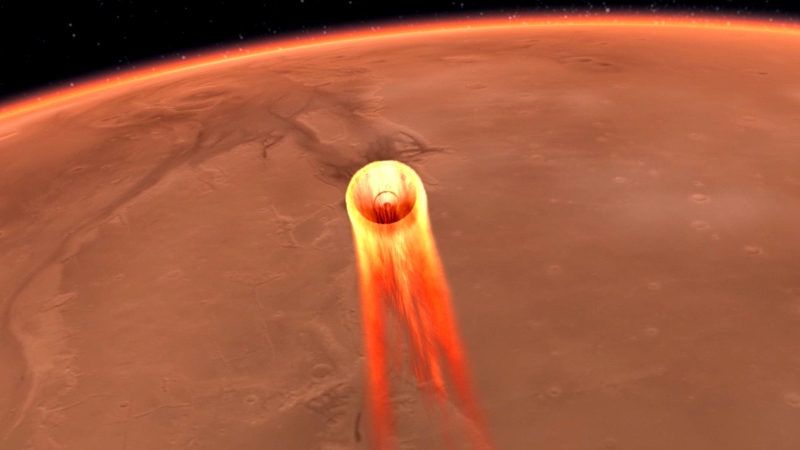
Deceleration in the atmosphere, NASA illustration
On the evening of November 25, the last preplant briefing was held , at which they said that:
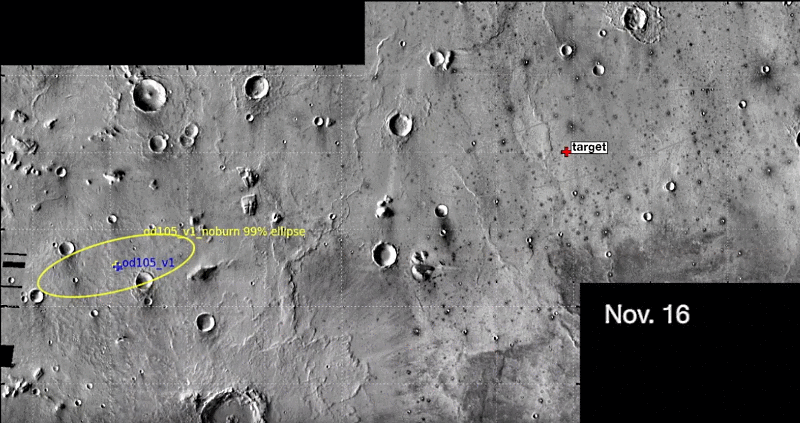
')
On the gif shows the calculated landing ellipse. On November 18, they made the fifth correction of the trajectory, so it moved to the right. Refinement of the trajectory of the apparatus showed that the ellipse went too far, and in its right side there is a less suitable relief. Therefore, the sixth correction, 22 hours before the landing, which was already thought to be canceled, after consulting, nevertheless decided to hold. InSight will change speed only by a few centimeters per second and will have to move the calculated ellipse by 17 km.
The main source of information about the status of InSight will be the Mars Reconnaisance Orbiter - a device that has been operating in Mars orbit for many years. But information from it will be available only after 3 hours. At the same time, stations on Earth will receive InSight signals directly. They will measure its Doppler shift associated with changes in probe speed, therefore, they will most likely be able to fix the opening of the parachute, the discharge of the heat shield and, of course, the landing. InSight must also send a signal in the X-range after a successful landing. Previous missions to Mars worked on similar algorithms, and practice has shown that there is little information, or it comes late. Therefore, as an experiment, two cubsats are flying alongside InSight - MarCO -A and -B.
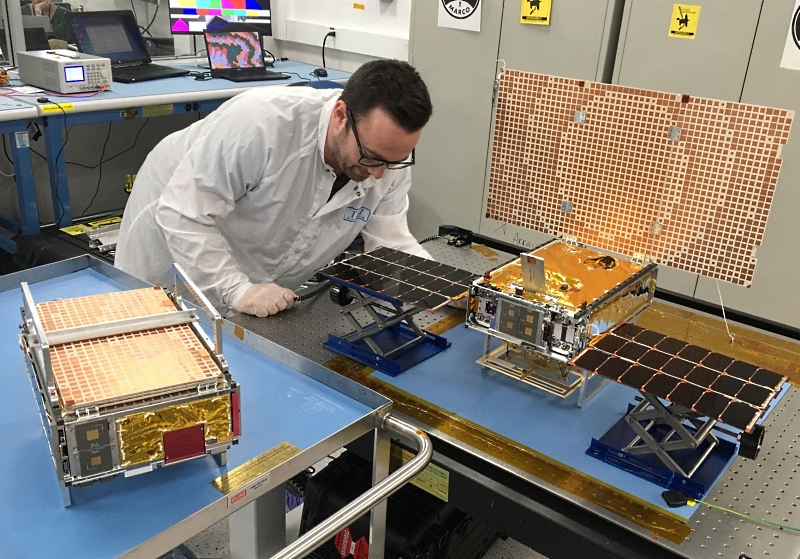
MarCO, NASA photo
Their task will be to receive real-time data from InSight in the VHF band and relaying them to Earth in the X-band. So far, both MarCO are working normally, but since this is the first time that such an attempt is being carried out, there is no guarantee that everything will be successful.

Mutual arrangement of devices
If all goes well, the probe will have time to partially transfer one photo of the landing site. It is expected that it will be very "boring", without stones and irregularities. This not only improves the safety of the landing, but is also useful for science - I remind you that one of the tasks of InSight will be to immerse in Mars a five-meter tape with thermometers that stones will interfere with. At the briefing, the creators of the device expressed confidence that the probe would sink at least 3 meters, and, most likely, it would be able to unfold completely.
At the same time, if the "beep" in the X-band is not fixed, this does not necessarily mean a complete failure of the mission - InSight can go into safe mode.
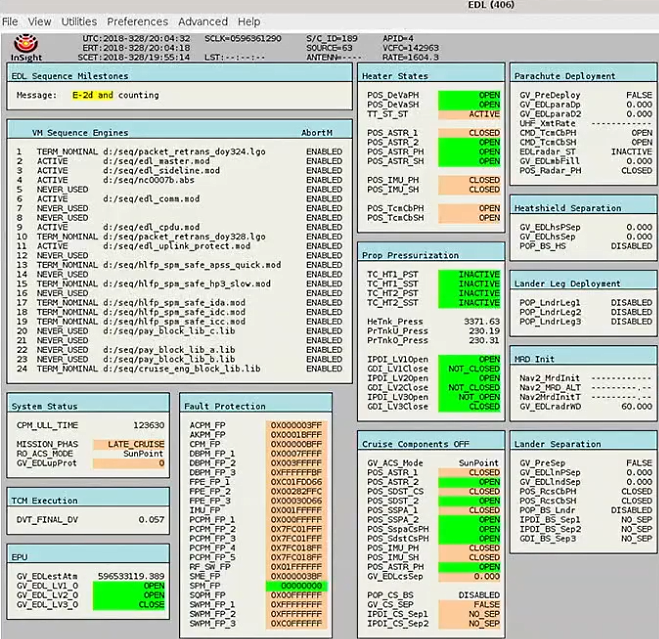
And here is one of the pages of the telemetry probe. Operators of the MCC will peer into them, observing the landing.
It is also worth noting that the critical stage of deploying solar panels will end more than five hours after planting, and InSight scientific instruments will be unloaded to the surface for more than two months. In more detail about InSight devices it is possible to read here .
As in the case of the Curiosity rover, the landing is called "seven minutes of horror," although in the case of the InSight it will last six and a half minutes. Landing consists of three stages. After resetting the migratory stage shortly before entering the atmosphere, InSight extinguishes approximately 90% of the energy, slowing down in the atmosphere, covered by an aerial shell with thermal protection. Then about 90% of the remaining energy will take over the supersonic parachute. And, finally, dropping the bottom of the aerial shell and opening the landing pads, InSight will jump down and begin to descend on impulse engines. More recently, Lockheed Martin released an epic video about landing.
But we have an even more interactive way to look at the landing of the InSight, because the enthusiast brianj made an addition for the Orbiter space simulator. At the same time, both the simulator and the add-on are free. So, we will need:
Unpack the add-on to the simulator folder and select the script InSight Mars Approach
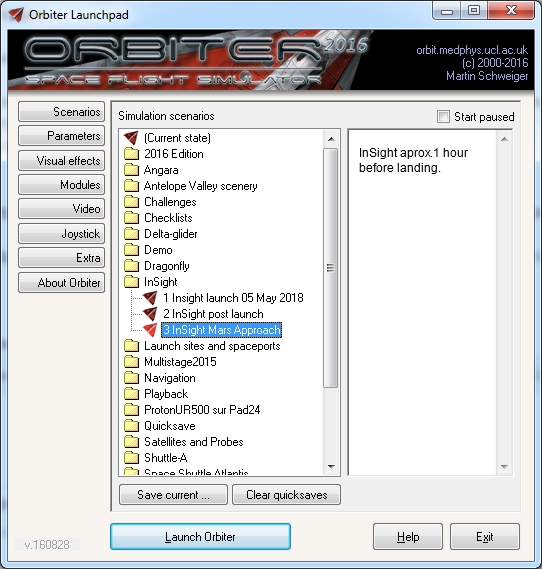
The script is good because it does not require any action from the user, you just look at the landing.
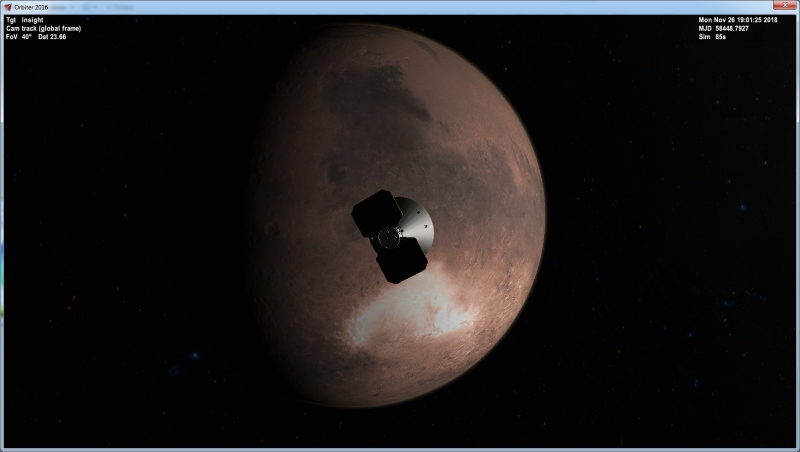
We fly to Mars. Acceleration / deceleration of R / T time, camera rotation after pressing the right mouse button.

Use the J button to reset the migratory stage.
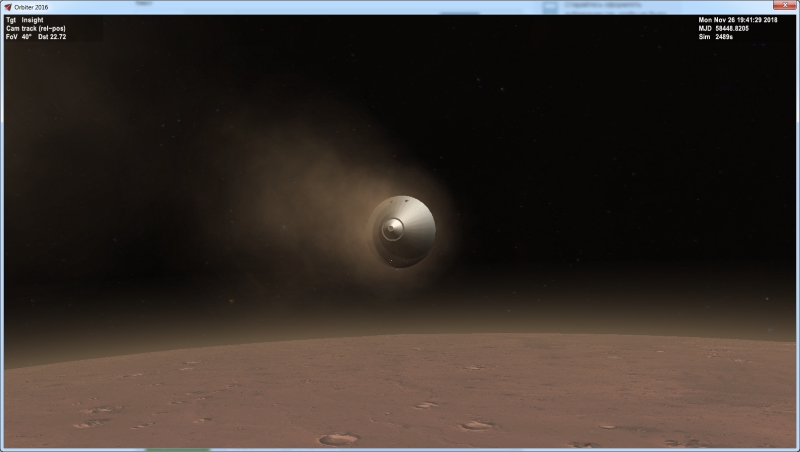
The initial speed of entry into the atmosphere is about 5.5 km / s.

Parachute descent, heat shield discharged, supports open.
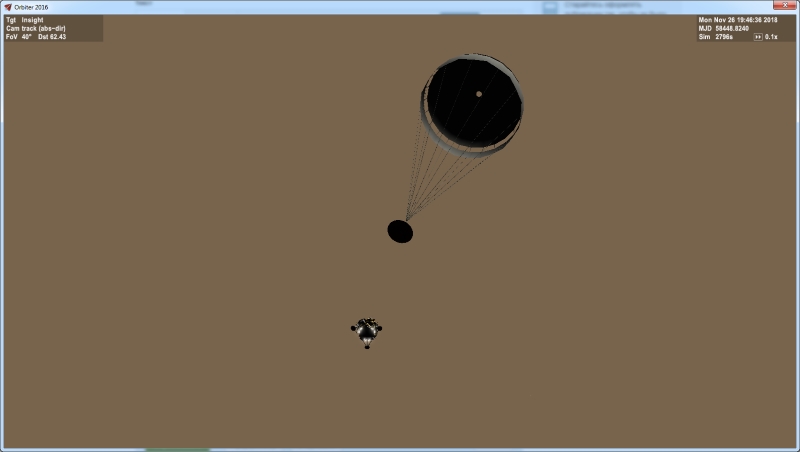
At an altitude of 1.1 km, the InSight is separated from the parachute and the upper part of the aerial shell.
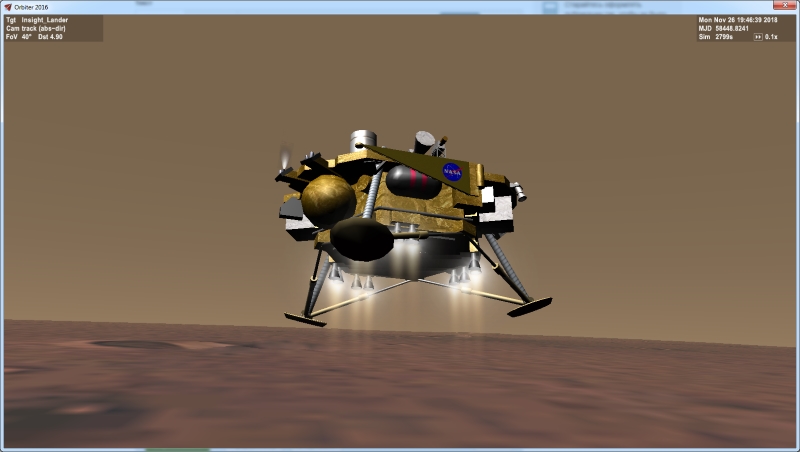
In the previous version of Orbiter, 2010, all the planets were perfectly round. Now there is an honest relief, and the landing algorithm must take into account the actual height above the surface.
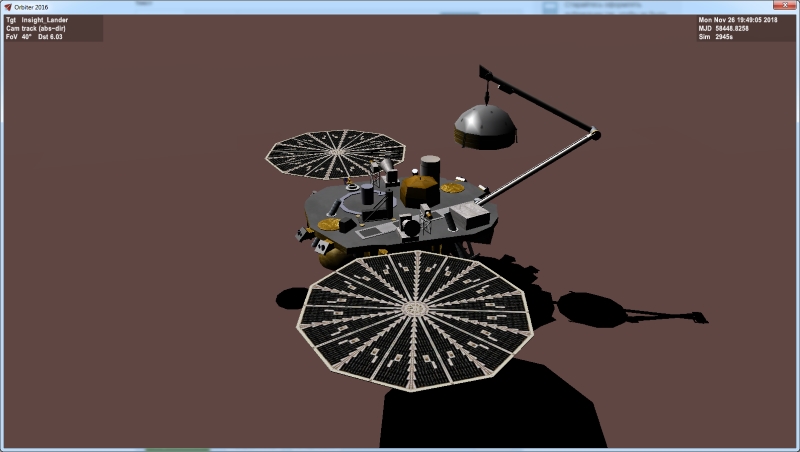
There is a landing! If desired, we open the solar panels with the K button, then use the V, B, N buttons (Shift-V, B, N - in the opposite direction) to turn the manipulator, G (grab / release) - we lift the scientific instruments from the platform and set it to the surface.
Additional Information:
UPD: Landing is successful, the solar panels are revealed, there are the first photos.

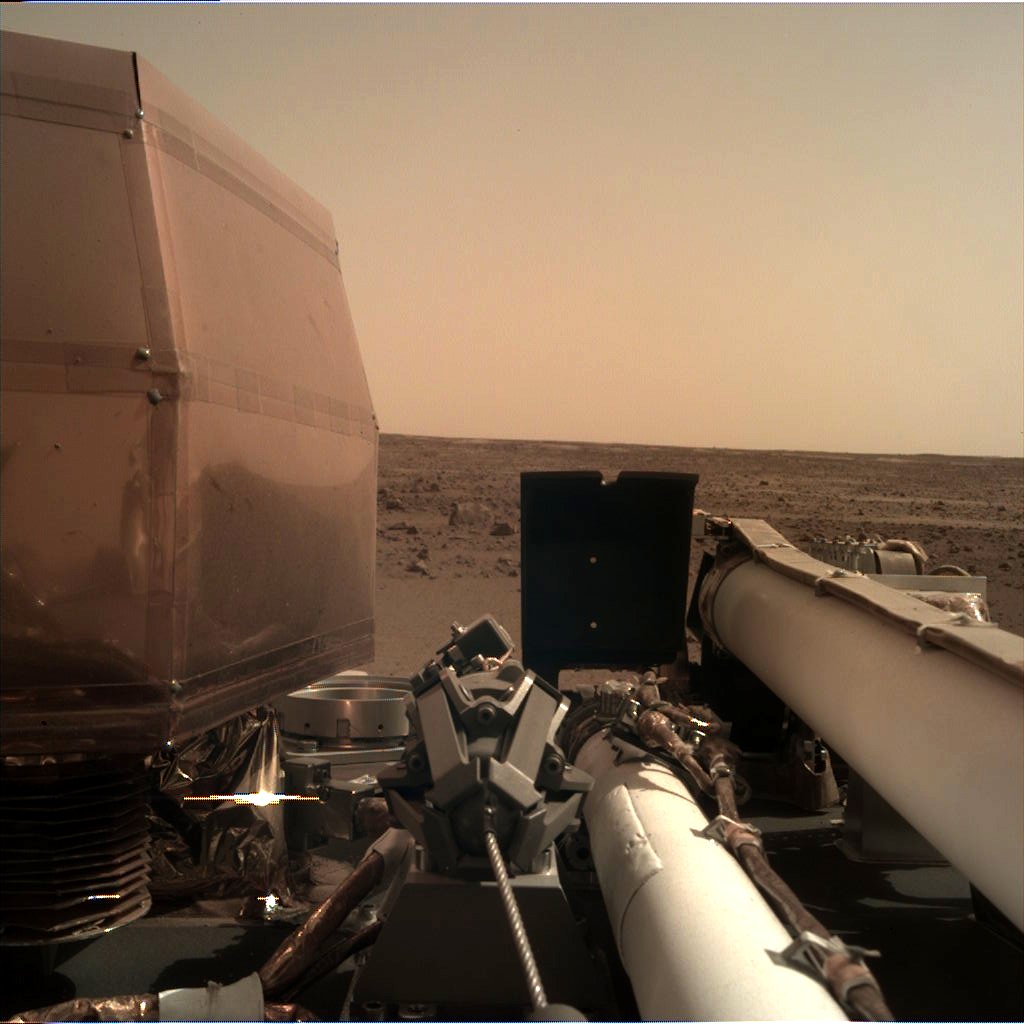

Deceleration in the atmosphere, NASA illustration
news
On the evening of November 25, the last preplant briefing was held , at which they said that:

')
On the gif shows the calculated landing ellipse. On November 18, they made the fifth correction of the trajectory, so it moved to the right. Refinement of the trajectory of the apparatus showed that the ellipse went too far, and in its right side there is a less suitable relief. Therefore, the sixth correction, 22 hours before the landing, which was already thought to be canceled, after consulting, nevertheless decided to hold. InSight will change speed only by a few centimeters per second and will have to move the calculated ellipse by 17 km.
The main source of information about the status of InSight will be the Mars Reconnaisance Orbiter - a device that has been operating in Mars orbit for many years. But information from it will be available only after 3 hours. At the same time, stations on Earth will receive InSight signals directly. They will measure its Doppler shift associated with changes in probe speed, therefore, they will most likely be able to fix the opening of the parachute, the discharge of the heat shield and, of course, the landing. InSight must also send a signal in the X-range after a successful landing. Previous missions to Mars worked on similar algorithms, and practice has shown that there is little information, or it comes late. Therefore, as an experiment, two cubsats are flying alongside InSight - MarCO -A and -B.

MarCO, NASA photo
Their task will be to receive real-time data from InSight in the VHF band and relaying them to Earth in the X-band. So far, both MarCO are working normally, but since this is the first time that such an attempt is being carried out, there is no guarantee that everything will be successful.

Mutual arrangement of devices
If all goes well, the probe will have time to partially transfer one photo of the landing site. It is expected that it will be very "boring", without stones and irregularities. This not only improves the safety of the landing, but is also useful for science - I remind you that one of the tasks of InSight will be to immerse in Mars a five-meter tape with thermometers that stones will interfere with. At the briefing, the creators of the device expressed confidence that the probe would sink at least 3 meters, and, most likely, it would be able to unfold completely.
At the same time, if the "beep" in the X-band is not fixed, this does not necessarily mean a complete failure of the mission - InSight can go into safe mode.

And here is one of the pages of the telemetry probe. Operators of the MCC will peer into them, observing the landing.
It is also worth noting that the critical stage of deploying solar panels will end more than five hours after planting, and InSight scientific instruments will be unloaded to the surface for more than two months. In more detail about InSight devices it is possible to read here .
Landing
As in the case of the Curiosity rover, the landing is called "seven minutes of horror," although in the case of the InSight it will last six and a half minutes. Landing consists of three stages. After resetting the migratory stage shortly before entering the atmosphere, InSight extinguishes approximately 90% of the energy, slowing down in the atmosphere, covered by an aerial shell with thermal protection. Then about 90% of the remaining energy will take over the supersonic parachute. And, finally, dropping the bottom of the aerial shell and opening the landing pads, InSight will jump down and begin to descend on impulse engines. More recently, Lockheed Martin released an epic video about landing.
But we have an even more interactive way to look at the landing of the InSight, because the enthusiast brianj made an addition for the Orbiter space simulator. At the same time, both the simulator and the add-on are free. So, we will need:
- Simulator Orbiter version 2016
- InSight add-on
Unpack the add-on to the simulator folder and select the script InSight Mars Approach

The script is good because it does not require any action from the user, you just look at the landing.

We fly to Mars. Acceleration / deceleration of R / T time, camera rotation after pressing the right mouse button.

Use the J button to reset the migratory stage.

The initial speed of entry into the atmosphere is about 5.5 km / s.

Parachute descent, heat shield discharged, supports open.

At an altitude of 1.1 km, the InSight is separated from the parachute and the upper part of the aerial shell.

In the previous version of Orbiter, 2010, all the planets were perfectly round. Now there is an honest relief, and the landing algorithm must take into account the actual height above the surface.

There is a landing! If desired, we open the solar panels with the K button, then use the V, B, N buttons (Shift-V, B, N - in the opposite direction) to turn the manipulator, G (grab / release) - we lift the scientific instruments from the platform and set it to the surface.
Additional Information:
- Detailed story about InSight
- Other flights in Orbiter
UPD: Landing is successful, the solar panels are revealed, there are the first photos.


Source: https://habr.com/ru/post/431006/
All Articles